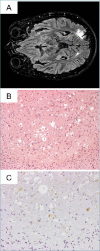Newly recognised Tumour Types in Glioneuronal tumours according to the 5th edition of the CNS WHO Classification
- PMID: 36534423
- PMCID: PMC9763980
- DOI: 10.32074/1591-951X-819
Newly recognised Tumour Types in Glioneuronal tumours according to the 5th edition of the CNS WHO Classification
Abstract
Glioneuronal tumours (GNT) are uncommon neoplasms, characterised by glial and neuronal differentiation.
In the 5th edition of the World Health Organization (WHO) Classification, they are grouped under the heading "Glioneuronal and neuronal tumours", which comprises fourteen different tumours, among which the diffuse glioneuronal tumour with oligodendroglioma-like cells and nuclear clusters (DGONC), myxoyd glioneuronal tumour (MGT) and multinodular and vacuolating neuronal tumour (MNVNT) are new types.
MGT and MNVNT are classified WHO grade 1 and may be recognised and diagnosed by peculiar clinical-pathological features. DGONC was not assigned a WHO grade and was only provisionally included among GNT, due to the possibility that it rather represents an embryonal tumour type or subtype. Although the histopathological characteristics may be useful for its identification, the specific methylation profile is an essential diagnostic criterion for DGONC.
Keywords: diffuse glioneuronal tumour with oligodendroglioma-like cells and nuclear clusters; glioneuronal tumours; multinodular and vacuolating neuronal tumour; myxoyd glioneuronal tumour.
Copyright © 2022 Società Italiana di Anatomia Patologica e Citopatologia Diagnostica, Divisione Italiana della International Academy of Pathology.
Figures



Similar articles
-
The 2021 WHO Classification of Tumors of the Central Nervous System: An update on pediatric low-grade gliomas and glioneuronal tumors.Brain Pathol. 2022 Jul;32(4):e13060. doi: 10.1111/bpa.13060. Epub 2022 Feb 25. Brain Pathol. 2022. PMID: 35218102 Free PMC article. Review.
-
Diffuse glioneuronal tumour with oligodendroglioma-like features and nuclear clusters (DGONC) - a molecularly defined glioneuronal CNS tumour class displaying recurrent monosomy 14.Neuropathol Appl Neurobiol. 2020 Aug;46(5):422-430. doi: 10.1111/nan.12590. Epub 2020 Feb 5. Neuropathol Appl Neurobiol. 2020. PMID: 31867747
-
Neuronal Brain Tumors.2022 Nov 21. In: StatPearls [Internet]. Treasure Island (FL): StatPearls Publishing; 2025 Jan–. 2022 Nov 21. In: StatPearls [Internet]. Treasure Island (FL): StatPearls Publishing; 2025 Jan–. PMID: 35015431 Free Books & Documents.
-
Cytopathology of glioneuronal and neuronal tumours with histological correlations.Cytopathology. 2024 Sep;35(5):545-555. doi: 10.1111/cyt.13308. Epub 2023 Sep 23. Cytopathology. 2024. PMID: 37740719 Review.
-
Emerging glioneuronal and neuronal tumors: case-based review.Brain Tumor Pathol. 2022 Apr;39(2):65-78. doi: 10.1007/s10014-021-00420-3. Epub 2022 Jan 20. Brain Tumor Pathol. 2022. PMID: 35048219 Review.
Cited by
-
Pediatric CNS tumors and 2021 WHO classification: what do oncologists need from pathologists?Front Mol Neurosci. 2024 Mar 13;17:1268038. doi: 10.3389/fnmol.2024.1268038. eCollection 2024. Front Mol Neurosci. 2024. PMID: 38544524 Free PMC article. Review.
-
Introduction.Pathologica. 2022 Dec;114(6):395-396. doi: 10.32074/1591-951X-839. Pathologica. 2022. PMID: 36534418 Free PMC article. No abstract available.
-
Myxoid glioneuronal tumor of the septum pellucidum in pediatric patients: a case report and comprehensive review of the literature.Childs Nerv Syst. 2024 Nov 26;41(1):2. doi: 10.1007/s00381-024-06660-w. Childs Nerv Syst. 2024. PMID: 39589532 Review.
-
Current status of DNA methylation profiling in neuro-oncology as a diagnostic support tool: A review.Neurooncol Pract. 2023 Jul 22;10(6):518-526. doi: 10.1093/nop/npad040. eCollection 2023 Dec. Neurooncol Pract. 2023. PMID: 38009119 Free PMC article. Review.
-
Multinodular and Vacuolating Neuronal Tumor Initially Misdiagnosed as Acute Cerebral Infarction Presenting With Thunderclap Headache.J Clin Neurol. 2024 Mar;20(2):217-219. doi: 10.3988/jcn.2023.0337. Epub 2024 Jan 5. J Clin Neurol. 2024. PMID: 38212667 Free PMC article. No abstract available.
References
-
- Louis DN, Perry A, Reifenberger G, et al. . The 2016 World Health Organization Classification of Tumors of the Central Nervous System: a summary. Acta Neuropathol 2016;131;803-820. https://doi.org/10.1007/s00401-016-1545-1 10.1007/s00401-016-1545-1 - DOI - PubMed
-
- Perry A, Brat DJ. Neuronal and Glioneuronal Neoplasms. In: Perry A, Brat DJ, eds. Practical Surgical Neuropathology: A Diagnostic Approach A Volume in the Pattern Recognition Series. Second Ed. Philadelphia, PA: Elsevier Inc; 2018, pp. 183-217. https://doi.org/10.1016/B978-0-323-44941-0.00010-2 10.1016/B978-0-323-44941-0.00010-2 - DOI
-
- Brat DJ, Ellison DW, Figarella-Brangen D, et al., eds. WHO Classification of Tumours. Central nervous system tumours. Fifth Edition. Lyon: International Agency for Research on Cancer; 2021.
-
- Capper D, Stichel D, Sahm F, et al. . Practical implementation of DNA methylation and copy-number-based CNS tumor diagnostics: the Heidelberg experience. Acta Neuropathol 2018;136:181-210. https://doi.org/https://doi.org/10.1007/s00401-018-1879-y 10.1007/s00401-018-1879-y - DOI - PMC - PubMed
-
- Deng MY, Sill M, Sturm D, et al. . Diffuse glioneuronal tumour with oligodendroglioma-like features and nuclear clusters (DGONC) - a molecularly defined glioneuronal CNS tumour class displaying recurrent monosomy 14. Neuropathol Appl Neurobiol 2020;46:422-430. https://doi.org/10.1111/nan.12590 10.1111/nan.12590 - DOI - PubMed
Publication types
MeSH terms
LinkOut - more resources
Full Text Sources
Medical

